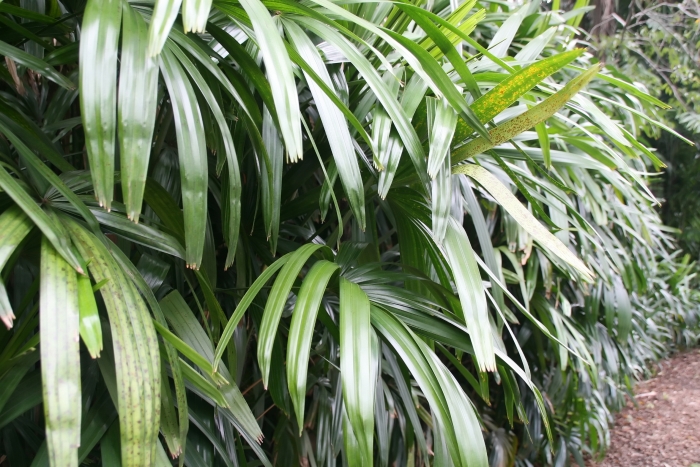Bamboo Palm
(Rhapis excelsa)
Bamboo Palm (Rhapis excelsa)
/
/

Photo by David J. Stang
CC BY-SA 4.0
Image By:
Photo by David J. Stang
Recorded By:
Copyright:
CC BY-SA 4.0
Copyright Notice:
Photo by: Photo by David J. Stang | License Type: CC BY-SA 4.0 | License URL: https://creativecommons.org/licenses/by-sa/4.0 | Uploader: David Stang | Publisher: Wikimedia Commons | Title: Rhapis_excelsa_13zz.jpg | Notes: User created page with UploadWizard |

























Estimated Native Range
Summary
Rhapis excelsa, commonly known as Bamboo Palm or Lady Palm, is an evergreen shrub native to understory forest areas and shaded, moist spots in China and Vietnam. It typically grows up to 4 meters in height and forms dense, bamboo-like clumps up to 30 mm in diameter. The palmate leaves are glossy and evergreen, divided into broad, ribbed segments that give a lush, tropical appearance. Bamboo Palm is usually dioecious, with separate male and female plants. It produces inconspicuous, small, spirally-arranged yellow flowers with three petals fused at the base, followed by fleshy, white fruit. However, it more commonly propagates through underground rhizome offshoots.
Bamboo Palm is valued for its air-purifying qualities and its ability to thrive in low-light conditions, making it a popular choice for indoor environments and shaded outdoor areas. It has earned the Royal Horticultural Society’s Award of Garden Merit for its ornamental qualities. This palm prefers part shade to full shade and requires medium water and well-draining soil to prevent root rot. It is often used in container plantings, as a houseplant, or in shaded landscape beds. While generally pest-resistant, it can be susceptible to spider mites and mealybugs in dry, indoor conditions.CC BY-SA 4.0
Bamboo Palm is valued for its air-purifying qualities and its ability to thrive in low-light conditions, making it a popular choice for indoor environments and shaded outdoor areas. It has earned the Royal Horticultural Society’s Award of Garden Merit for its ornamental qualities. This palm prefers part shade to full shade and requires medium water and well-draining soil to prevent root rot. It is often used in container plantings, as a houseplant, or in shaded landscape beds. While generally pest-resistant, it can be susceptible to spider mites and mealybugs in dry, indoor conditions.CC BY-SA 4.0
Plant Description
- Plant Type: Shrub
- Height: 6-15 feet
- Width: 6-15 feet
- Growth Rate: Slow
- Flower Color: N/A
- Flowering Season: Spring
- Leaf Retention: Evergreen
Growth Requirements
- Sun: Part Shade, Full Shade
- Water: Medium
- Drainage: Medium
Common Uses
Drought Tolerant, Hedges, Low Maintenance, Potted Plant, Street Planting
Natural Habitat
Understory forest areas and shaded, moist spots in China and Vietnam
Other Names
Common Names: Broadleaf Lady Palm
Scientific Names: , Rhapis excelsa, Trachycarpus excelsus, Rhapis flabelliformis, Rhapis divaricata, Rhapis javanica, Chamaerops excelsa var. gracilis, Chamaerops kwanwortsik, Rhapis aspera, Rhapis cordata
GBIF Accepted Name: Rhapis excelsa (Thunb.) A.Henry